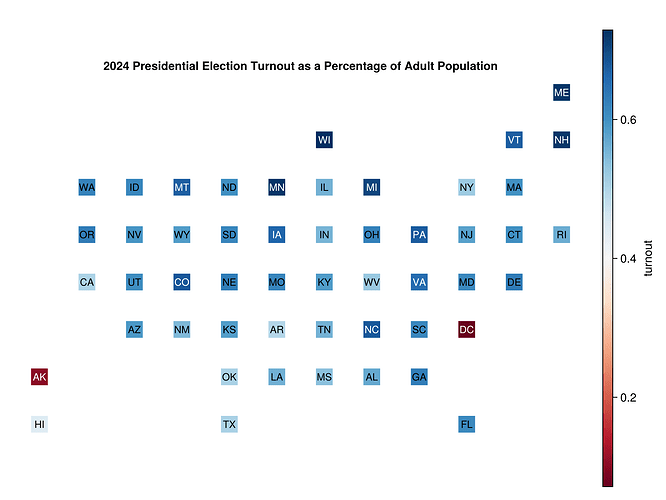That was interesting. It was my first time loading GMT and it loaded 1.30.0, I did an ]up and it updated to 1.30.1.
I got past the first line and then the third line errored. When I add quotes it seems to work however.
julia> wms = wmsinfo(http://tiles.maps.eox.at/wms?);
ERROR: ParseError:
# Error @ REPL[11]:1:20
wms = wmsinfo(http://tiles.maps.eox.at/wms?);
# └┘ ── not a unary operator
Stacktrace:
[1] top-level scope
@ none:1
julia> wms = wmsinfo("http://tiles.maps.eox.at/wms?");
julia>
Everything then seems to run except the last line which errors:
julia> viz(Df, region=img, proj=:guess, plot=(data=Df, lw=0), title="Sate Color (median)")
Access is denied.
psconvert [ERROR]: System call [@"C:\Users\jakez\.julia\artifacts\cca2b0693e0ae8df2daca37d0779bb7209f32c5f\bin\gs.exe" -q -dNOSAFER -dNOPAUSE -dBATCH -sDEVICE=bbox -DPSL_no_pagefill -dMaxBitmap=2147483647 -dUseFastColor=true "C:\Users\jakez\AppData\Local\Temp/GMTjl_jakez.ps" 2> "./psconvert_27032c.bb"] returned error 1.
ERROR: Something went wrong when calling the module. GMT error number = 79
Stacktrace:
[1] error(s::String)
@ Base .\error.jl:35
[2] gmt(::String)
@ GMT C:\Users\jakez\.julia\packages\GMT\acUHa\src\gmt_main.jl:166
[3] showfig(d::Dict{Symbol, Any}, fname_ps::String, fname_ext::String, opt_T::String, K::Bool, fname::String)
@ GMT C:\Users\jakez\.julia\packages\GMT\acUHa\src\common_options.jl:4194
[4] finish_PS_module_barr_last(d::Dict{…}, cmd::Vector{…}, fname::String, fname_ext::String, opt_extra::String, output::String, opt_T::String, K::Bool, P::Nothing)
@ GMT C:\Users\jakez\.julia\packages\GMT\acUHa\src\common_options.jl:4558
[5] finish_PS_module(d::Dict{…}, cmd::Vector{…}, opt_extra::String, K::Bool, O::Bool, finish::Bool, args::Vector{…})
@ GMT C:\Users\jakez\.julia\packages\GMT\acUHa\src\common_options.jl:4496
[6] prep_and_call_finish_PS_module
@ C:\Users\jakez\.julia\packages\GMT\acUHa\src\common_options.jl:4407 [inlined]
[7] prep_and_call_finish_PS_module(d::Dict{…}, cmd::Vector{…}, opt_extra::String, K::Bool, O::Bool, finish::Bool, arg1::Vector{…}, arg2::Nothing, arg3::Nothing, arg4::Nothing)
@ GMT C:\Users\jakez\.julia\packages\GMT\acUHa\src\common_options.jl:4405
[8] _common_plot_xyz(cmd0::String, arg1::Vector{…}, caller::String, O::Bool, K::Bool, is3D::Bool, d::Dict{…})
@ GMT C:\Users\jakez\.julia\packages\GMT\acUHa\src\psxy.jl:253
[9] #common_plot_xyz#924
@ C:\Users\jakez\.julia\packages\GMT\acUHa\src\psxy.jl:13 [inlined]
[10] common_plot_xyz
@ C:\Users\jakez\.julia\packages\GMT\acUHa\src\psxy.jl:11 [inlined]
[11] plot(arg1::Vector{…}; first::Bool, kw::@Kwargs{…})
@ GMT C:\Users\jakez\.julia\packages\GMT\acUHa\src\plot.jl:122
[12] plot
@ C:\Users\jakez\.julia\packages\GMT\acUHa\src\plot.jl:101 [inlined]
[13] imshow(arg1::Vector{…}, x::Vector{…}, y::Vector{…}; kw::@Kwargs{…})
@ GMT C:\Users\jakez\.julia\packages\GMT\acUHa\src\imshow.jl:86
[14] imshow (repeats 2 times)
@ C:\Users\jakez\.julia\packages\GMT\acUHa\src\imshow.jl:36 [inlined]
[15] top-level scope
@ REPL[15]:1
Some type information was truncated. Use `show(err)` to see complete types.



